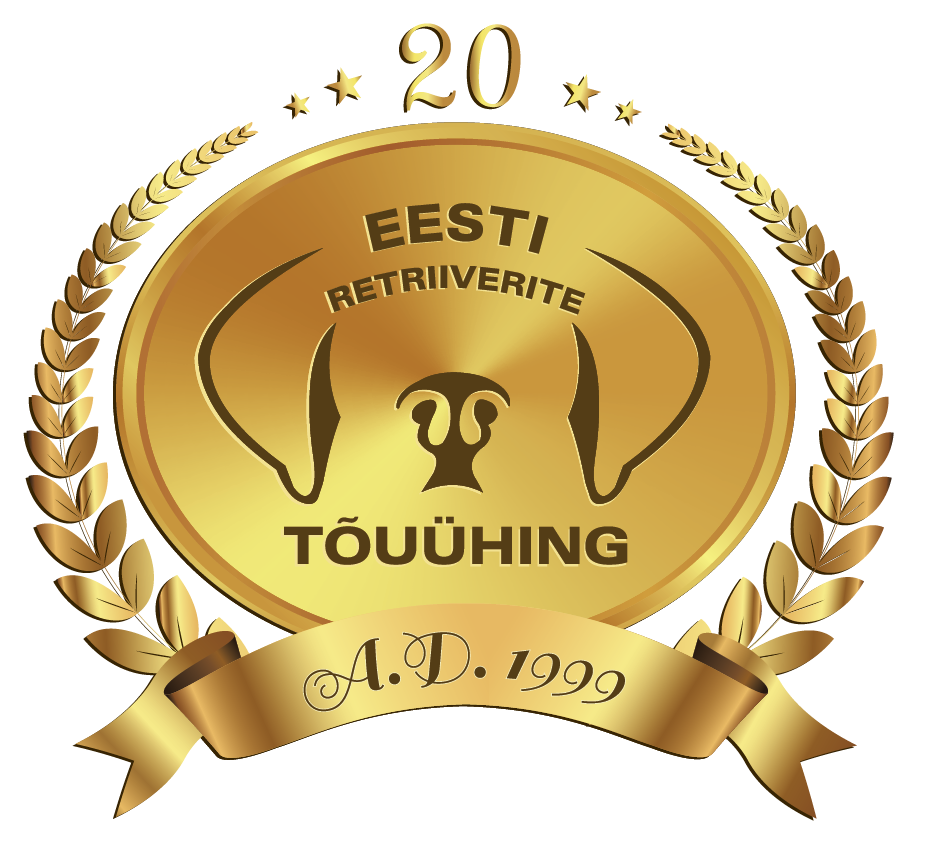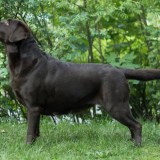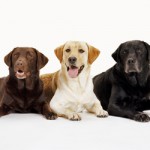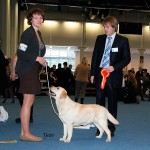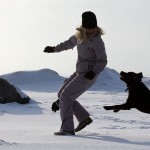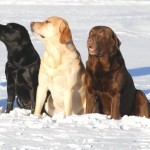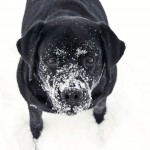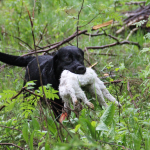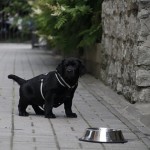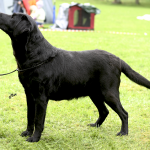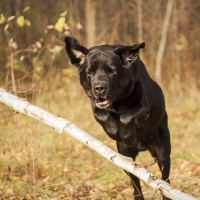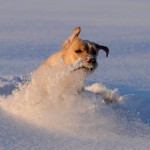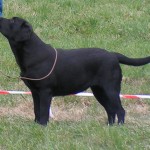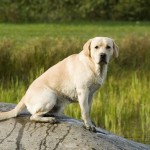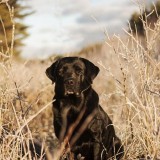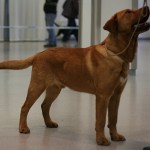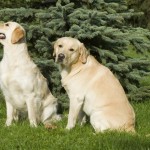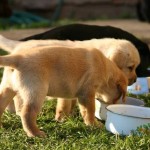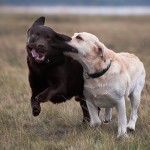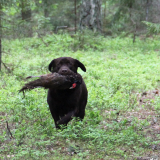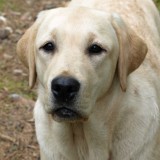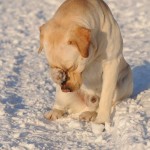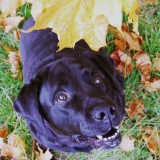
Family: gundog, retriever
Place of Origin: Canada
Date of Origin: 1800s
Original Function: water retrieving
Primary Current Function: water retrieving, assistance, obedience competition, retriever field trials
The Labrador Retriever (also Labrador, or Lab for short) is one of several kinds of retriever, a type of gun dog. A breed characteristic is webbed paws for swimming, useful for the breed’s original purpose of retrieving fishing nets. This and their subsequent use as hunting companions, gave them the name retriever.
The dogs of this breed are very loving, kind and compassionate to their masters. The Labrador is the most popular breed of dog (by registered ownership) in the world, and is, by a large margin, the most popular breed by registration in Canada, the United States (since 1991), and the United Kingdom. It is also the most popular breed of assistance dog in Canada, the United States, Australia, United Kingdom and many other countries,[citation needed] as well as being widely used by police and other official bodies for their detection and working abilities. Typically, Labradors are athletic, and love to swim, play catch and retrieve games, and are good with young children.
- Labradori retriiveri tõu ajalugu
- History of Labrador Retrievers in Estonia
- Labradori retriiverite aretusprogramm
- Mida teada enne labradori retriiveri võtmist
- Labradoride karvavärvused, pärandumine ja vead
- Korduma kippuvad küsimused – labradori retriiver
History
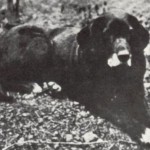
St.Johni koer Nell
The modern Labrador’s ancestors originated on the island of Newfoundland, now part of the province of Newfoundland and Labrador, Canada. The breed emerged over time from the St. John’s Water Dog, (also a founding breed of the Newfoundland dog) through ad-hoc breedings by early settlers in the mid to late 16th century.
The forebears of the St. John’s Dog are not known, but were likely a random-bred mix of English, Irish, and Portuguese working breeds. The Newfoundland (known then as the Greater Newfoundland) is likely a result of the St. John’s Dog breeding with mastiffs brought to the island by the generations of Portuguese fishermen who had been fishing offshore since the 1600s.
The smaller short-coat St. John’s Dog (also known as the Lesser Newfoundland) was used for retrieval and pulling in nets from the water. These smaller dogs were the forebears of the Labrador Retriever. The white chest, feet, chin, and muzzle – known as tuxedo markings – characteristic of the St. John’s Dog often appear in Lab mixes, and will occasionally manifest in Labs as a small white spot on the chest (known as a medallion) or stray white hairs on the feet or muzzle..
The St. John’s area of Newfoundland was settled mainly by the English and Irish. Local fishermen originally used the St. John’s dog to assist in carrying ropes between boats, towing dories, and helping to retrieve fishnets in the water. The Labrador’s loyalty and hard working behavior earned him a place on many a fisherman’s boat.
A number of these dogs were brought back to the Poole area of England in the early 1800s, then the hub of the Newfoundland fishing trade, by the gentry, and became prized as sporting and waterfowl hunting dogs. A few kennels breeding these grew up in England; at the same time a combination of sheep protection policy (Newfoundland) and rabies quarantine (England) led to their gradual demise in their country of origin.
A surviving picture of Buccleuch Avon (b.1885), a foundational dog of many modern Labrador lineages.The first and second Earls of Malmesbury, who bred for duck shooting on his estate, and the 5th and 6th Dukes of Buccleuch, and youngest son Lord George William Montagu-Douglas-Scott, were instrumental in developing and establishing the modern Labrador breed in nineteenth century England. The dogs Avon (“Buccleuch Avon”) and Ned given by Malmesbury to assist the Duke of Buccleuch’s breeding program in the 1880s are considered the ancestors of all modern Labradors.
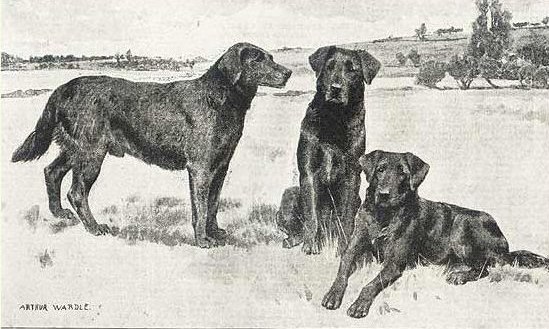
Buccleuch Avon, Ned ja Gyp
The first St. John’s Dog was said to be brought to England around 1820; however, the breed’s reputation had spread to England long before. There is a story that the Earl of Malmesbury saw a St. John’s Dog on a fishing boat and immediately made arrangements with traders to have some of these dogs exported to England. These ancestors of the first labradors so impressed the Earl with their skill and ability for retrieving anything within the water and on shore that he devoted his entire kennel to developing and stabilizing the breed.
Early descriptions
Several early descriptions of the St. John’s Water Dog exist. In 1822, explorer W.E. Cormack crossed the island of Newfoundland by foot. In his journal he wrote “The dogs are admirably trained as retrievers in fowling, and are otherwise useful…..The smooth or short haired dog is preferred because in frosty weather the long haired kind become encumbered with ice on coming out of the water.”
Another early report by a Colonel Hawker described the dog as “by far the best for any kind of shooting. He is generally black and no bigger than a Pointer, very fine in legs, with short, smooth hair and does not carry his tail so much curled as the other; is extremely quick, running, swimming and fighting….and their sense of smell is hardly to be credited….”
In his book Excursions In and About Newfoundland During the Years 1839 and 1840, the geologist Joseph Beete Jukes describes the St. John’s Water Dog. “A thin, short-haired, black dog came off-shore to us to-day. The animal was of a breed very different from what we understand by the term Newfoundland dog in England. He had a thin, tapering snout, a long thin tail, and rather thin, but powerful legs, with a lank body, – the hair short and smooth.” wrote Jukes. “These are the most abundant dogs in the country…They are no means handsome, but are generally more intelligent and useful than the others…I observed he once or twice put his foot in the water and paddled it about. This foot was white, and Harvey said he did it to “toil” or entice the fish. The whole proceeding struck me as remarkable, more especially as they said he had never been taught anything of the kind.”
Name
The foundational breed of what is now the Labrador Retriever was known as the St. John’s Water Dog, St. John’s Dog, or Lesser Newfoundland. When the dogs were later brought to England, they were named after the geographic area known as “the Labrador” or simply Labrador to distinguish them from the larger Newfoundland breed, even though the breed was from the more southern Avalon Peninsula.
Historical landmarks
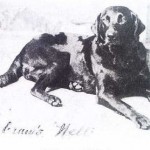
Nell
The first written reference to the breed was in 1814 (“Instructions to Young Sportsmen” by Colonel Peter Hawker), the first painting in 1823 (“Cora. A Labrador Bitch” by Edwin Landseer), and the first photograph in 1856 (the Earl of Home’s dog “Nell”, described both as a Labrador and a St. Johns dog).
By 1870 the name Labrador Retriever became common in England. The first yellow Labrador on record was born in 1899 (Ben of Hyde, kennels of Major C.J. Radclyffe), and the breed was recognised by the Kennel Club in 1903. The first American Kennel Club (AKC) registration was in 1917. The chocolate Labrador emerged in the 1930s, although liver spotted pups were documented being born at the Buccleuch kennels in 1892. The St. John’s dog survived until the early 1980s, the last two individuals being photographed in old age around 1981.
History of subtypes
Yellow and chocolate pups, would occasionally appear (although often culled), until finally gaining acceptance in the 20th century.
The first recognised yellow Labrador was Ben of Hyde, born 1899, and chocolate labs became more established in the 1930s.
Yellow (and related shades)
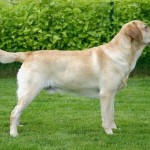 In the early years of the breed through to the mid-20th century, Labradors of a shade we would now call “yellow” were in fact a dark, almost butterscotch, colour (visible in early yellow Labrador photographs). The shade was known as “Golden” until required to be changed by the UK Kennel Club, on the grounds that “Gold” was not actually a colour. Over the 20th century a preference for far lighter shades of yellow through to cream prevailed, until today most yellow labs are of this shade.
In the early years of the breed through to the mid-20th century, Labradors of a shade we would now call “yellow” were in fact a dark, almost butterscotch, colour (visible in early yellow Labrador photographs). The shade was known as “Golden” until required to be changed by the UK Kennel Club, on the grounds that “Gold” was not actually a colour. Over the 20th century a preference for far lighter shades of yellow through to cream prevailed, until today most yellow labs are of this shade.
Interest in the darker shades of gold and fox red were re-established by English breeders in the 1980s, and three dogs were instrumental in this change: Balrion King Frost (black, born approx. 1976) who consistently sired “very dark yellow” offspring and is credited as having “the biggest influence in the re-development of the fox red shade”, and his great-grandson, the likewise famous Wynfaul Tabasco (b.1986), described as “the father of the modern fox red Labrador”, and the only modern fox red Show Champion in the UK. Other dogs, such as Red Alert and Scrimshaw Placido Flamingo, are also credited with passing on the genes into more than one renowned bloodline.
Chocolate labradors
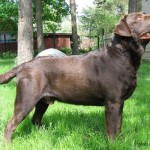 Jack Vanderwyk traces the origins of all Chocolate labradors listed on the LabradorNet database (some 34,000 Labrador dogs of all shades) to eight original bloodlines. However, the shade was not seen as a distinct colour until the 20th century; before then according to Vanderwyk, such dogs can be traced but were not registered. A degree of crossbreeding with Flatcoat or Chesapeake Bay retrievers was also documented in the early 20th century, prior to recognition. Chocolate labradors were also well established in the early 20th century at the kennels of the Earl of Feversham, and Lady Ward of Chiltonfoliat.
Jack Vanderwyk traces the origins of all Chocolate labradors listed on the LabradorNet database (some 34,000 Labrador dogs of all shades) to eight original bloodlines. However, the shade was not seen as a distinct colour until the 20th century; before then according to Vanderwyk, such dogs can be traced but were not registered. A degree of crossbreeding with Flatcoat or Chesapeake Bay retrievers was also documented in the early 20th century, prior to recognition. Chocolate labradors were also well established in the early 20th century at the kennels of the Earl of Feversham, and Lady Ward of Chiltonfoliat.
The bloodlines as traced by Vanderwyk each lead back to three black labradors in the 1880s—Buccleuch Avon (m), and his sire and dam, Malmesbury Tramp (m), and Malmesbury June (f). Morningtown Tobla is also named as an important intermediary, and according to the studbook of Buccleuch Kennels, the chocolates in that kennel came through FTW Peter of Faskally (1908).
Description
Appearance
Labradors are relatively large, with males typically weighing 29–41 kg (65-90 pounds) and females 25–32 kg (55–71 lb). Labs weighing close to or over 100 lbs are considered obese or having a major fault under American Kennel Club standards, although some labs weigh significantly more. The majority of the characteristics of this breed, with the exception of colour, are the result of breeding to produce a working retriever.
As with some other breeds, the Conformation (typically “English”, “show” or “bench”) and the Field (typically “American” or “working”) lines differ, although both lines are bred in both countries. In general, however, Conformation Labs tend to be bred as medium-sized dogs, shorter and stockier with fuller faces and a slightly calmer nature than their Field counterparts, which are often bred as taller, lighter-framed dogs, with slightly less broad faces and a slightly longer nose; however Field labs should still be proportional and fit within AKC standards. With field labs, excessively long noses, thin heads, long legs and lanky frames are not considered standard. These two types are informal and not codified or standardised; no distinction is made by the AKC or other kennel clubs, but the two types come from different breeding lines. Australian stock also exists; though not seen in the west, they are common in Asia.
The breed tends to shed hair twice annually, or regularly throughout the year in temperate climates. Some labs shed considerably; however, individual labs vary. Labrador hair is usually fairly short and straight, and the tail quite broad and strong. The otter-like tail and webbed toes of the Labrador Retriever make them excellent swimmers. The webbing between their toes can also serve as a “snowshoe” in colder climates and keep snow from balling up between their toes- a condition that can be painful to other breeds with hair between the toes. Their interwoven coat is also relatively waterproof, providing more assistance for swimming.
Official breed standards
There is a great deal of variety among Labs. The following characteristics are typical of the conformation show bred (bench-bred) lines of this breed in the United States, and are based on the AKC standard. Significant differences between US and UK standards are noted.
Size: Labs are a medium-large but compact breed. They should have an appearance of proportionality. They should be as long from the withers to the base of the tail as they are from the floor to the withers. Males should stand 22.5–24.5 inches (57–62 cm) tall at the withers and weigh 65–80 lb (29–36 kg). Females should stand 21.5–23.5 inches (55–60 cm) and weigh 55–70 lb (25–32 kg). By comparison under UK Kennel Club standards, height should be 22–22.5 inches (56–57 cm) for males, and 21.5–22 inches (55–56 cm) for females.[17]
Coat: The Lab’s coat should be short and dense, but not wiry. The coat is described as ‘water-resistant’ or more accurately ‘water-repellent’ so that the dog does not get cold when taking to water in the winter. That means that the dog naturally has a slightly dry, oily coat. Acceptable colours are black, yellow (ranging from ivory or creme to fox red), and chocolate.
Head: The head should be broad with a pronounced stop and slightly pronounced brow. The eyes should be kind and expressive. Appropriate eye colours are brown and hazel. The lining around the eyes should be black. The ears should hang close to the head and are set slightly above the eyes.
Jaws: The jaws should be strong and powerful. The muzzle should be of medium length, and should not be too tapered. The jaws should hang slightly and curve gracefully back.
Body: The body should be strong and muscular with a level top line.
The tail and coat are designated “distinctive [or distinguishing] features” of the Labrador by both the Kennel Club and AKC. The AKC adds that “true Labrador Retriever temperament is as much a hallmark of the breed as the ‘otter’ tail.”
As well, Labradors should not have droopy eyes (like a Basset Hound). The skin should be relatively tight, and you should not be able to see the pinks on the inside of their lids.
Colour
Different shades of yellow: a usual yellow shade, and a fox red shade.
The three primary colour varieties of the Labrador RetrieverLabrador Retrievers are registered in three colours: black (a solid black colour), yellow (anything from light cream to “fox-red”), and chocolate (medium to dark brown). Some Labrador retrievers can have markings such as white patches on their chest and other areas, but most commonly they are one solid colour.
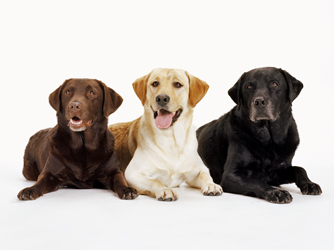
Puppies of all colours can potentially occur in the same litter. Colour is determined primarily by two genes. The first gene (the B locus) determines the density of the coat’s pigment granules: dense granules result in a black coat, sparse ones give a chocolate coat. The second (D) locus determines whether the pigment is produced at all. A dog with the recessive d allele will produce little pigment and will be yellow regardless of its genotype at the B locus. Variations in numerous other genes control the subtler details of the coat’s colouration, which in yellow Labs varies from white to light gold to a fox red. Chocolate and black Labs’ noses will match the coat colour.
Nose and skin pigmentation
Because Labrador colouration is controlled by multiple genes, it is possible for recessive genes to emerge some generations later and also there can sometimes be unexpected pigmentation effects to different parts of the body. Pigmentation effects appear in regard to yellow Labradors, and sometimes chocolate, and hence the majority of this section covers pigmentation within the yellow Labrador. The most common places where pigmentation is visible are the nose, lips, gums, feet, tail, and the rims of the eyes, which may be black, brown, light yellow-brown (“liver”, caused by having two genes for chocolate), or several other colours. A Labrador can carry genes for a different colour, for example a black Labrador can carry recessive chocolate and yellow genes, and a yellow Labrador can carry recessive genes for the other two colours. DNA testing can reveal some aspects of these. Less common pigmentations (other than pink) are a fault, not a disqualification, and hence such dogs are still permitted to be shown.
The intensity of black pigment on yellow Labs is controlled by a separate gene independent of the fur colouring. Yellow Labradors usually have black noses, which may gradually turn pink with age (called “snow nose” or “winter nose”). This is due to a reduction in the enzyme tyrosinase which indirectly controls the production of melanin, a dark colouring. Tyrosinase is temperature dependent—hence light colouration can be seasonal, due to cold weather—and is less produced with increasing age two years old onwards. As a result, the nose colour of most yellow Labs becomes a somewhat pink shade as they grow older.
The nose and lips are pink or flesh-coloured, the defining aspect of Dudley pigmentation. A colouration known as “Dudley” is also possible. Dudleys are variously defined as yellow Labs which have unpigmented (pink) noses (LRC), yellow with liver/chocolate pigmentation (AKC), or “flesh coloured” in addition to having the same colour around the rims of the eye, rather than having black or dark brown pigmentation. A yellow Labrador with brown or chocolate pigmentation, for example, a brown or chocolate nose, is not necessarily a Dudley, though according to the AKC’s current standard it would be if it has chocolate rims around the eyes (or more accurately of the genotype eebb). Breed standards for Labradors considers a true Dudley to be a disqualifying feature in a conformation show Lab, such as one with a thoroughly pink nose or one lacking in any pigment along with flesh coloured rims around the eyes. True Dudleys are extremely rare.
Breeding in order to correct pigmentation often lacks dependability. Because colour is determined by many genes, some of which are recessive, crossbreeding a pigmentation non-standard yellow Labrador to a black Labrador may not correct the matter or prevent future generations carrying the same recessive genes. For similar reasons, crossbreeding chocolate to yellow labs is also often avoided.
Show and field lines
Chocolate Labradors from field-bred stock are typically lighter in build and have a shorter coat than conformation show Labrador.There are significant differences between field and trial-bred (sometimes referred to as “American”) and show-bred (or “English”) lines of Labradors, arising as a result of specialised breeding. Dogs bred for hunting and field-trial work are selected first for working ability, where dogs bred to compete in conformation shows are selected for their conformation to the standards and characteristics sought by judges in the show ring.
Head and muzzle appearance: American or field (left), and English or show (right), showing the shorter muzzle length, more solid appearance head, and “pronounced” stop of the latter.While individual dogs may vary, in general show-bred Labradors are heavier built, slightly shorter-bodied, and have a thicker coat and tail. Field Labradors are generally longer legged, lighter, and more lithe in build. In the head, show Labradors tend to have broader heads, better defined stops, and more powerful necks, while field Labradors have lighter and slightly narrower heads with longer muzzles. Field-bred Labradors are commonly higher energy and more high-strung compared to the Labrador bred for conformation showing, and as a consequence may be more suited to working relationships than being a “family pet”. Some breeders, especially those specialising in the field type, feel that breed shows do not adequately recognise their type of dog, leading to occasional debate regarding officially splitting the breed into subtypes.
In the United States, the AKC and the Labrador’s breed club have set the breed standard to accommodate the field-bred Labrador somewhat. For instance, the AKC withers-height standards allow conformation dogs to be slightly taller than the equivalent British standard. However, dual champions, or dogs that excel in both the field and the show ring, are becoming more unusual.
Temperament
A Labrador participating in dog agilityLabradors are a well-balanced, friendly and versatile breed, adaptable to a wide range of functions as well as making very good pets. As a rule they are not excessively prone to being territorial, pining, insecure, aggressive, destructive, hypersensitive, or other difficult traits which sometimes manifest in a variety of breeds. As the name suggests, they are excellent retrievers. Labradors instinctively enjoy holding objects and even hands or arms in their mouths, which they can do with great gentleness (a Labrador can carry an egg in its mouth without breaking it). They are also known to have a very soft feel to the mouth, as a result of being bred to retrieve game such as waterfowl. They are prone to chewing objects (though they can be trained out of this behavior). The Labrador Retriever’s coat repels water to some extent, thus facilitating the extensive use of the dog in waterfowl hunting.
Labradors enjoy playing with waterLabradors have a reputation as a very even-tempered breed and an excellent family dog (including a good reputation with children of all ages and other animals), but some lines (particularly those that have continued to be bred specifically for their skills at working in the field rather than for their appearance) are particularly fast and athletic. Their fun-loving boisterousness and lack of fear may require training and firm handling at times to ensure it does not get out of hand—an uncontrolled adult can be quite problematic. Females may be slightly more independent than males. Labradors mature at around three years of age; before this time they can have a significant degree of puppy-like energy, often mislabelled as being hyperactive. Because of their enthusiasm, leash-training early on is suggested to prevent pulling when full-grown. Labradors often enjoy retrieving a ball endlessly and other forms of activity (such as agility, frisbee, or flyball).
Although they will sometimes bark at noise, especially noise from an unseen source (“alarm barking”), Labs are usually not noisy or territorial. They are often very easygoing and trusting with strangers, and therefore are not usually suitable as guard dogs.
Labradors have a well-known reputation for appetite, and some individuals may be highly indiscriminate, eating digestible and non-food objects alike. They are persuasive and persistent in requesting food. For this reason, the Labrador owner must carefully control his/her dog’s food intake to avoid obesity and its associated health problems (see below).
The steady temperament of Labs and their ability to learn make them an ideal breed for search and rescue, detection, and therapy work. Their primary working role in the field continues to be that of a hunting retriever.
Use as working dogs
Labradors are a very popular selection for use as guide dogs.Labradors are an intelligent breed with a good work ethic and generally good temperaments (breed statistics show that 91.5% of Labradors who were tested passed the American Temperament Test.) Common working roles for Labradors include: hunting, tracking and detection (they have a great sense of smell which helps when working in these areas), disabled-assistance, carting, and therapy work. Approximately 60–70% of all guide dogs in Canada are Labradors; other common breeds are Golden Retrievers and German Shepherd Dogs.
The high intelligence, initiative and self-direction of Labradors in working roles is exemplified by dogs such as Endal, who during a 2001 emergency placed an unconscious human being in the recovery position, retrieved his mobile phone from beneath the car, fetched a blanket and covered him, barked at nearby dwellings for assistance, and then ran to a nearby hotel to obtain help. A number of labradors have also been taught to assist their owner in removing money and credit cards from ATMs with prior training.
Health
Many dogs, including Labs such as this twelve year old, show distinct whitening of the coat as they grow older; especially around the muzzle.Labrador pups should not be brought home before they are 7–10 weeks old. Their life expectancy is generally 10 to 12 years, and it is a healthy breed with relatively few major problems. Notable issues related to health and well-being include:
Inherited disorders
Labs are somewhat prone to hip and elbow dysplasia, especially the larger dogs though not as much as some other breeds. Hip scores are recommended before breeding and often joint supplements are recommended.
Labs also suffer from the risk of knee problems. A luxating patella is a common occurrence in the knee where the leg is often bow shaped.
Eye problems are also possible in some Labs, particularly progressive retinal atrophy, cataracts, corneal dystrophy and retinal dysplasia. Dogs which are intended to be bred should be examined by a veterinary ophthalmologist for an eye score.
Hereditary myopathy, a rare inherited disorder that causes a deficiency in type II muscle fibre. Symptoms include a short stilted gait or “bunny hopping,” and in rare cases ventroflexion of the neck accompanied by a kyphotic posture.
There is a small incidence of other conditions, such as autoimmune diseases and deafness in labs, either congenitally or later in life.
Labradors often suffer from exercise induced collapse, a syndrome that causes hyperthermia, weakness, collapse, and disorientation after short bouts of exercise.
Other disorders
Labs are sometimes prone to ear infection, because their floppy ears trap warm moist air. Labs who spend a lot of time in water are additionally prone to infection. This is easy to control, but needs regular checking to ensure that a problem is not building up unseen. A healthy Labrador ear should look clean and light pink (almost white) inside. Darker pink (or inflamed red), or brownish deposits, are a symptom of ear infection. The usual treatment is regular cleaning daily or twice daily (being careful not to force dirt into the sensitive inner ear) and sometimes medication (ear drops) for major cases. As a preventative measure, some owners clip the hair carefully around the ear and under the flap, to encourage better air flow. Labradors also get cases of allergic reactions to food or other environmental factors.
Obesity
Labradors can easily become overweight, due to their enjoyment of treats, hearty appetites, and endearing behaviour towards people. Lack of activity is also a contributing factor. A healthy Labrador should keep a very slight hourglass waist and be fit and light, rather than fat or heavy-set. Excessive weight is strongly implicated as a risk factor in the later development of hip dysplasia or other joint problems and diabetes, and also can contribute to general reduced health when older. Osteoarthritis is common in older, especially overweight, Labradors. A 14 year study covering 48 dogs by food manufacturer Purina showed that labs fed to maintain a lean body shape outlived those fed freely, by around two years, emphasizing the importance of not over-feeding.
Appearance around the world
In the United States, the breed gained wider recognition following a 1928 American Kennel Gazette article, “Meet the Labrador Retriever”. Before this time, the AKC had only registered 23 Labradors in the country, in part because US and UK hunting styles had different requirements. Labradors acquired popularity as hunting dogs during the 1920s and especially after World War II, as they gained recognition as combining some of the best traits of the two favourite United States breeds as both game finders and water dogs.
Outside North America and Western Europe, the Labrador arrived later. For example, the Russian Retriever Club traces the arrival of Labradors to the late 1960s, as household pets of diplomats and others in the foreign ministry. The establishment of the breed in the Commonwealth of Independent States (ex-USSR) was initially hindered by the relatively small numbers of Labradors and great distances involved, leading to difficulty establishing breedings and bloodlines; at the start of the 1980s, home-born dogs were still regularly supplemented by further imports from overseas. Difficulties such as these initially led to Labradors being tacitly cross-bred to other types of retriever. In the 1990s, improved access to overseas shows and bloodlines is said to have helped this situation become regularised.
Read:
Warning: Undefined variable $u_date in /data01/virt4399/domeenid/www.retriiverid.ee/htdocs/wp-content/themes/Erty/page.php on line 33
Viimane uuendus: 2016/04/29
